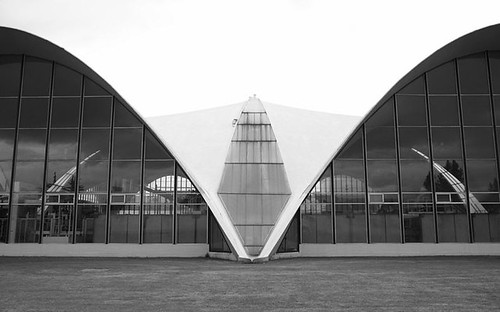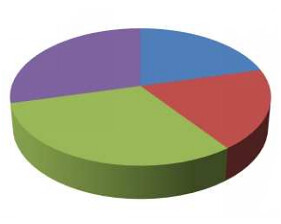According to the World Business Council for Sustainable
Development (
WBCSD), “concrete is the most widely used material on earth, apart
from water, with nearly three tons used annually for each man, woman, and
child.” Most structural engineers are familiar with efficient design practices
for working with concrete, but there are sustainable considerations that should
also be taken into account. There are at least three areas in which the
characteristics of concrete can be used sustainably:
1.
Exposed concrete can be used as both an interior
or exterior finish, thereby reducing the additional material cost of cladding,
painting, installing drop ceilings and sheeting, etc.
2.
Concrete structures intrinsically have more
thermal mass – a property that enables heat energy to be absorbed, stored, and
later released, giving greater comfort in the both the heat of summer and the
cold of winter.
3.
Carefully considered mix designs can reduce the
embodied carbon intrinsic to concrete, improve long-term durability, and still
provide sufficient workability.
Unfortunately, the production of
portland cement releases a
high volume of carbon. Approximately 40% of embodied carbon is associated with
powering the extremely hot furnaces needed for the transformation. Cement
manufacturers are experimenting with ways to become more efficient. (4)
Structural engineers can specify that cement be sourced from plants scored by
the
Energy Star Industrial Focus Program with an Energy Performance Indicator
(EPI) above 75.
The remaining 60% of embodied carbon in cement is a result
of
calcination, the intrinsic chemical reaction whereby limestone is
transformed into
clinker, on the way to becoming cement. Therefore, the primary
means of greening concrete is to reduce the amount of portland cement in the
mix.
Fortunately structural engineers can have great control over
the mix designs selected. Some relatively simple steps can be taken to ensure
that more sustainable concrete mixes are used on your job site. These can be
simplified into four rules of thumb: (5) reduce water content, (6) use
complimentary cementitious materials (CCMs), (7) use the maximum aggregate
size, and (8) specify proper strengths.
Reduce water content.
Keep the water/binder ratio low, and although less cement is used, the same
strength can be achieved. A low w/b is also good for durability. Based on the
relationship of specific gravity between concrete and water, a w/b ratio
greater than 0.32 is most likely to result in free water that is not bound to
the binder paste. This results in unwanted voids and drying shrinkage as the
free water evaporates (instead of being consumed in the chemical reaction).
High
slump is often desirable for workability. (9) Fly ash
and
superplasticizers help improve workability without increasing water. The
spherical shape of fly ash acts as a physical lubricant and thus aids in cement
hydration. Water-reducers likewise increase slump, however, too much of these
admixtures can cause segregation and excessive bleed water. A good rule of
thumb is to limit the water-reducers or superplasticizers to 2 percent of the
mass of the binders.
 |
| Fly Ash (Meryman 2007) |
Use complimentary
cementitious materials (CCMs). Fly ash, slag, natural
pozzolans, and
ultrafines can be used in lieu of portland cement. Many such materials have
less embodied carbon or are recycled industrial byproducts. The basic chemical
reaction between portland cement and water produces
calcium hydroxide (CH).
Many CCMs then react with the CH to produce
calcium silicate hydrate (C-S-H), which provides a much stronger bond,
particularly around the aggregates.
With regard to durability, C-S-H is known to be a much
denser product and therefore less permeable. Non-cement binders also tend to
reduce the heat of hydration. Although specific alkali-silica reactions are
known, CCMs generally enhance both strength and durability. (10) For a more
in-depth analysis of durable mixes, designers can utilize the
Life-365 freesoftware from the National Ready Mix Concrete Association (
NRMCA).
Use the maximum
aggregate size. This reduces the surface area that the binder paste needs
to cover thereby keeping the past volume lower. Normally available aggregates
are stronger than the surrounding hardened paste.
Specify proper
strengths. Choose target strengths at ages that realistically reflect the
needs of the project. Recall the above described chemical reaction involving
CSMs: C-S-H takes longer to develop and the conventional 28-day period may not
be sufficient. If possible, specify 56 or even 90 day strength. This gives mix
designers at the batch plant more freedom to utilize some CCMs.
The above recommendations were sourced from
SustainabilityGuidelines for the Structural Engineer, Chapter 3.2 – Concrete. Current and
former SEI Sustinability Committee Members influential in authoring the
referenced chapter include: Helena Meryman, Sarah Vaughan, Alan Kren, and Iyad
Alsamsam. This summary is by Ken Maschke, P.E., S.E., LEED A.P., associate with
Thornton Tomasetti in Chicago, IL.




















